Mid-Ocean
Ridges,
Magmatic
Processes, Fluid Flow
& Textural
Studies
(The Textural Analysis Research Team)

This
web page is dedicated to the memory of Dr Bob Hunter. It was Bob who formed the
TART and who is responsible for
enthusing and educating many of the people listed on this page. His impact on
us was immense & he is sadly missed.
The main objective of the ‘team’ is to better understand
the processes involved in the generation, migration and emplacement of all
melts & magmas. In particular, one of our main objectives is to better
understand how oceanic crust is created. Our approach is multi-disciplinary,
involving mathematical modeling, geochemistry, geochronology, geophysics,
laboratory observation (textures & microstructures), structural geology and
fieldwork. Current field projects include ongoing study of the East Pacific Rise, the Mid Cayman Rise, Mid Atlantic and
South West Indian Ridges, the Dufek layered
Intrusion
(Antarctica); the Rum layered Intrusion (NW Scotland), the Bushveldt layered Intrusion (S. Africa),
and the Stillwater Intrusion (Montana).
Contents
 Research
Areas
Research
Areas
 Processes at Slow Spreading Ridges
Processes at Slow Spreading Ridges
 Komatiites & Mantle Plumes
Komatiites & Mantle Plumes
 Layered
Intrusions
Layered
Intrusions
 Rock Textures
Rock Textures
 Fluid Flow &
Physical Properties of Rocks
Fluid Flow &
Physical Properties of Rocks
 Origin of Granitic Magmas
Origin of Granitic Magmas
 Origin
& Evolution of Sedimentary Basins
Origin
& Evolution of Sedimentary Basins
 Future Research
Future Research
 People,
Past & Present
People,
Past & Present
 Biographical
Information & who to contact: Dr. M.J. Cheadle mailto:(cheadle@uwyo.edu)
Biographical
Information & who to contact: Dr. M.J. Cheadle mailto:(cheadle@uwyo.edu)
Research
Areas
Processes at Slow and Ultra-Slow
Spreading Ridges
The origin and
construction of oceanic crust: tectonics vs. magmatism.
(Dr. Mike Cheadle, Dr Kay Achenbach,
Scott Badham; Tyler Brown, Chris Christofferson, Dr Graham Baines, Lauren Colwell, Dr. Craig Grimes (Ohio University),
Lars Hansen, Nicole Schoolmeesters, Dr Josh Schwartz, Dr. Barbara John, Dr Tim Schroeder (Bennington
College), Dr Henry Dick (Wood Hole), Professor Nick Kusznir
(University of Liverpool, UK), Dr Pete Reiners
(University of Arizona), Dr Joe Wooden (Stanford University).
Slow spreading ridges are 'arguably' one
of the last frontiers of plate tectonics, and there are lots of fascinating
questions to investigate. Professor Barbara John and I have a group who use all
techniques (structure, petrology, geochemistry & geophysics) to study these
problems. Lars Hansen recently completed
a Masters thesis looking at the high temperature deformation mechanisms of the
Kane Oceanic Core Complex Detachment Fault in order to understand the
conditions and depth at which the faults form. Scott Badham
is looking at the role of Fe-Ti oxides in localizing faulting at Mid Ocean
Ridges. Kay Achenbach has been studying the depth of strain localization in
mantle peridotites. And Graham Baines and Craig Grimes have shown that the rate
of slip of oceanic detachment faults is much greater than the symmetrical plate
half spreading rate. This suggests that oceanic detachment faults are
effectively the plate boundary at mid ocean ridges! and
implies that detachment faulting leads to ridge migration.
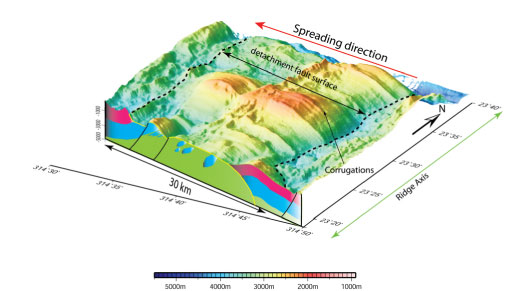
The
Kane Oceanic Core Complex; 23oN, Mid Atlantic Ridge;
nearly 30km of exposed detachment fault footwall.
We are also applying geo-chronologic and thermochronologic methods to address how oceanic crust
grows and how fast faults move. We are one of the first groups on the world to
do this. Put simply, uranium bearing minerals, such as zircon are much more
common in oceanic crust than conventionally thought (see pubs. below) and this
is allowing us to apply all the techniques developed for continental crust to
the study of cooling rates, accretion rates and faulting rates at Mid Oceanic
Ridges. We have NSF funding for this research and much of the geochronologic work is done in conjunction with Joe Wooden
at the Stanford/USGS SHRIMP facility. Graham Baines, Craig Grimes, Josh
Schwartz and Nicole Schoolmeesters have all used the U-Pb and (U-Th)/He methods to address various aspects of the growth of
oceanic crust. An important component of work is “going to sea” to collect
samples and explore the seafloor; our students have enjoyed cruises to the
Pacific, Atlantic and Indian Oceans. Current research areas: the Mid Cayman Rise, the South-West Indian
Ridge, the Mid Atlantic Ridge and the Gakkel Ridge.
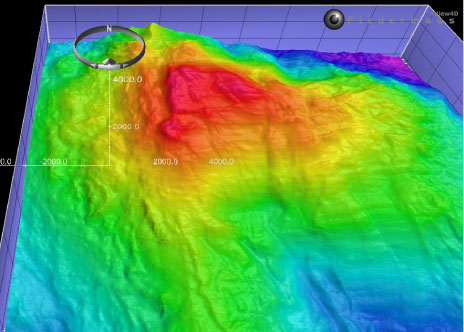
The
Mount Dent Oceanic Core Complex (OCC); Mid Cayman Rise.

Comparison of the Mount Dent OCC to the Ruby Mtns continental core complex in the Basin & Range. Mount Everest also shown for comparison.
Critical questions include:
i)
How
is mantle deformed and exposed at these ridges?
ii)
What
is the origin of anomalous uplift seen at inside corner highs and along
transverse ridges?
iii)
How
does magmatism occur at ultraslow spreading ridges?
iv)
At
what depths do gabbros crystallize?
v)
And
how do oceanic core complexes form?
We have just started a new initiative to look at how oceanic crust grows. Chris Christofferson just finished looking at the microstructures and fabrics of gabbros from oceanic core complexes and Tyler Brown is just beginning work on gabbros from the fast spreading East Pacific Rise, working with Laurence Coogan (University of Victoria) and Jeff Gee (Scripps). Next stop is IODP Leg 345 to Hess Deep to collect gabbros from the lowermost crust.
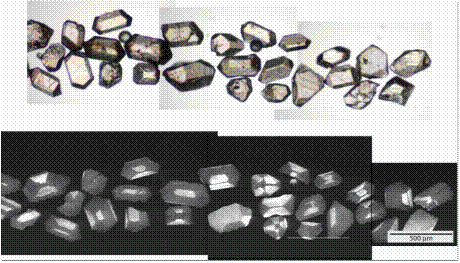
Zircons
separated from oceanic crust.
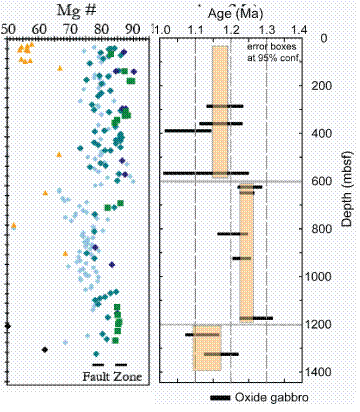
Deciphering
the construction of oceanic crust: Dating IODP Hole1309D (Grimes et al., 2008)
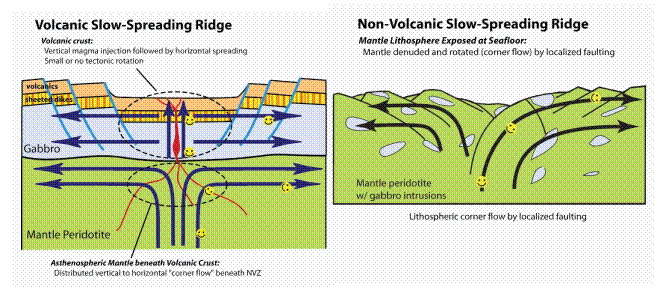
Tectonics
vs. Magmatism at slow spreading ridges (from
Schroeder et al., 2007)

The
Shinkai6500 (JAMSTEC), which is the deepest going manned submersible.
We used the
Shinkai6500 and the Kaiko ROV (Jamstec)
on a previous cruise to dive to the bottom of the ocean and investigate the
tectonic and magmatic processes occurring there.

A view of
the bottom and an anemone from the window of the submarine.
Relevant Publications:
Schoolmeesters, N., Cheadle, M.J., John, B.E., Reiners, P.W., Gee, J. and Grimes, C.B.,, The cooling history and the depth of detachment faulting at the Atlantis Massif oceanic core complex: Geochem. Geophys. Geosyst. (accepted),
Grimes, C. B., M. J. Cheadle, B. E. John, P. W. Reiners, and J. L. Wooden (2011), Cooling rates and the depth of detachment faulting at oceanic core complexes: Evidence from zircon Pb/U and (U-Th)/He ages, Geochem. Geophys. Geosyst., 12, Q0AG01, doi:10.1029/2010GC003391.
Achenbach, K.L.; Cheadle, M.J.; Faul, U.; Kelemen, P.; Swapp, S.; 2011, Lattice-preferred orientation and microstructure of peridotites from ODP Hole 1274A (15°39′N), Mid-Atlantic Ridge: Testing models of mantle upwelling and
tectonic exhumation. EPSL, 301, 199-212.
John, B.E., and Cheadle, M.J., 2010, Deformation and alteration associated with oceanic and continental detachment fault systems: are they similar?: in Rona, Devey, Dyment, and Murton, eds., Diversity of Hydrothermal Systems on Slow-spreading Ocean Ridges, AGU Monograph 188, p. 175-206.
Cheadle M.J. & Grimes, C.B., 2010. To Fault or Not to Fault, Nature Geosciences, News & Views, vol 3 454-456.
Schwartz, J.J. John, B.E., Cheadle, M.J., Wooden, J., Mazdab, F., Swapp, S, and Grimes, C.B., 2010, Dissolution-Reprecipitation of Igneous Zircon in Mid-Ocean Ridge Gabbro, Atlantis Bank, Southwest Indian Ridge: Chemical Geology, vol 274, p68-81.
Michael, P.J. & Cheadle, M.J., 2009, Making Crust. Science. (Perspectives) Vol. 323. no. 5917, pp. 1017 – 1018 DOI: 10.1126/science.1169556.
Schwartz, J.J., John, B.E., Cheadle, M.J., Reiners, P., & Baines, A.G., The cooling history of Atlantis Bank oceanic core complex: evidence for hydrothermal activity 2.6 Myr off-axis. Geochemistry, Geophysics, Geosystems (G3), 2009.
Baines, G., Cheadle, M.J., John, B.E., Grimes, C.B., and Wooden, J., Rapid accretion of gabbroic crust at Atlantis Bank on the ultra-slow-spreading SW Indian Ridge: EPSL, 2009 .
Grimes, C.B., John, B.E., Cheadle, M.J., Mazdab, F.K., Wooden, J., Swapp, S., and Schwartz, J., On the occurrence, trace element geochemistry, and crystallization history of zircon from in situ ocean lithosphere: Contributions to Mineralogy and Petrology. 2009
Baines, A.G., Cheadle,
M.J., John, B.E., and
Schwartz, J.J., 2008. Rate of detachment faulting at Atlantis Bank, South-west
Indian Ridge: evidence for 100% asymmetry during the formation of oceanic core complexes.
Earth and Planetary Science Letters, vol. 273, 105–114.
doi:10.1016/j.epsl.2008.06.013.
Grimes, C.B., John, B.E., Cheadle,
M.J., and Wooden, J.L., 2008. Evolution and timescales for accretion
of slow-spreading oceanic crust: constraints from high resolution U-Pb zircon dating of a gabbroic crustal
section at Atlantis Massif, 30º N, MAR: Geochemistry, Geophysics, Geosystems, vol. 9, no. 8, Q08012, doi:10.1029/2008GC002063.
Baines, A.G., Cheadle, M.J.,
Dick, H.J.B., Hosford-Scheirer, A., John, B.E., Kusznir, N.J., & Matsumoto. T., 2007,The
evolution of the Southwest Indian Ridge and the implications of major changes
in the ridge axis geometry since 25Ma. Geochemistry Geophysics Geosystems, vol. 8, doi:10.1029/2006GC001559.
Grimes, C.B.,
John, B.E., Kelemen, P.B., Mazdab,
F., Wooden, J., Cheadle, M.J.,Hanghoi,
K., and Schwartz, J.J., 2007, The trace element chemistry of zircons from
oceanic crust: A method for distinguishing detrital
zircon provenance: Geology vol. 35, 643–646, doi:10.1130/G23603A.1.
John, B.E., and Cheadle, M.J., 2007, Slow-spreading mid-ocean
ridges: McGraw-Hill Yearbook of Science and Technology, Tenth Edition.
Schroeder, T., Cheadle, M.J., Dick, H.J.B., Faul, U., Casey, J.F., and Kelemen,
P.B., 2007, Non-volcanic seafloor spreading and corner-flow rotation
accommodated by extensional faulting at 15°N on the Mid-Atlantic Ridge: A
structural synthesis of ODP Leg 209: Geochemistry Geophysics Geosystems, vol. 8, doi:10.1029/2006GC001567.
Schwartz, J.J.,
John, B.E.,
Cheadle, M.J., Miranda, E., Grimes, C., Wooden, J., and Dick, H. 2005. Growth and Construction of Oceanic Crust at Slow-Spreading Ridges,
Science, vol 310, p654-658.
John, B.E, Foster, D.A, Murphy, J.M., Cheadle, M.J.,
Fanning, C.M., Copeland, P. & Baines, A.G., 2004. Determining
the cooling history of in-situ lower oceanic crust-Atlantis Bank, SW Indian
Ridge. EPSL 222, 145-160.
Baines, A.G., Cheadle,
M.J., Dick, H.J.B., Scheirer, A.H., John, B.E., Kusznir, N.J.,
and Matsumoto, T., 2003, Mechanism for generating the anomalous uplift of
oceanic core complexes: Atlantis Bank,
southwest Indian Ridge: Geology, v. 31,
p. 1105-1108.
back to Contents
Komatiites
& Mantle Plumes
Komatiites, melting
in mantle plumes; temperature constraints on the mantle through time
(Dr Mike Cheadle, Dr Kath Silva, Dr Dougal
Jerram, with Prof. D. Sparks – Texas A & M
University, Prof. N.T. Arndt –Universite Joseph
Fourier Grenoble, Dr. Mary Gee & Prof. E.G. Nisbet-RHBNC).
Komatiites are the hottest lavas ever
erupted on Earth (eruption temperatures 1400-1600oC), and therefore
they place important constraints on the temperature of the mantle especially
during the Archaean, where they are most commonly
found. However their origin remains enigmatic, mainly because of their age and
restricted occurrence & because of their preservation. We have studied the
petrology, geochemistry and origin of the freshest known komatiites
from the Belingwe Greenstone Belt in Zimbabwe (2.7Ga).
Dissertation work by Kath Silva on the geochemistry on a complete komatiite sequence through the Belingwe
Greenstone Belt has been used to place constraints on how this greenstone belt
was formed.


Examples of
the well preserved Belingwe komatiites.
Spinifex texture from the upper part of the flows on
the left and the texture of the cumulate zones from the lower part of the flows
on the right.
The current ‘hot’ topic about komatiites
is ‘do they represent hot dry magmas or do they represent less hot, wet,
possibly subduction zone magmas’. Dr Mary Gee is
currently measuring water contents in melt inclusions from the Belingwe Komatiites using FTIR
methods. Initial results reveal very low water contents. If komatiites
are indeed ‘dry’ magmas, they must have formed in mantle plumes….. but the implications for Archaean
mantle temperatures are far ranging (+200-300oC hotter than today).
Prof. Dave Sparks has developed 3-D numerical models of the
temperature distribution within mantle plumes. We use these models, along with
parameterisations of the temperature and pressure dependence of the chemistry
of mantle melts, to predict the composition of melts produced by different
mantle plumes. We’ve investigated the effects of varying mantle temperature,
the variation in lithosphere thickness, and are now attempting to introduce the
effect of water on melting. The work has been used to predict the mantle
conditions required for the generation of komatiites,
and has led to predictions of Archaean mantle
temperatures.

Numerical
model showing two isothermal surfaces (green & blue) which show the effects
of dragging a lithospheric plate over an up-welling
mantle plume. Box depth corresponds to the depth of the upper mantle.
Relevant Publications:
Herzberg, C., Albarede, F., Arndt, N., Asimow,
P.D., Lesher, M., Niu, Y., Fitton, J.G., Cheadle,
M.J., and Saunders, A.D., 2007. Ultramafic
Igneous Rocks: A Challenge for Alternatives to the Plume Hypothesis. Geochemistry Geophysics Geosystems.
Volume 8, No. 2, Q02006, doi:10.1029/2006GC001390.
Arndt, N.T., Ginibre, C. Chauval, C., Albarede, F., Cheadle, M.J., Herzberg,
C., Jenner,
& Lahaye, Y., 1998. Were Komatiites Wet? Geology 26, 739-742.
Silva, K., Cheadle, M. J. & Nisbet E.G., 1997. The Origin of B-1 -zones in Komatiite Flows. Journal of Petrology, 38, 1565-1584.
Nisbet, E. G., Cheadle,
M.J., Arndt, N.T., and Bickle, M.J. (1993).
Constraining the potential temperature of the Archaean
mantle: a review of the evidence from komatiites. Lithos. 30: 291-307.
Renner, R., Nisbet, E.G., Cheadle,M.J.,
Arndt, N.T., Bickle, M.,Cameron,
W.E., 1993. Komatiite flows from the Reliance
Formation, Belingwe Belt, Zimbabwe: 1- Petrography
and Mineralogy. J. Petrology, 35, 361-400.
Nisbet, E.G., Arndt, N.T., Bickle,
M.J., Cameron, W.E., Chauvel, C., Cheadle, M.J., Hegner,
E., Kyser, T.K., Martin, A.,Renner,
R., Roedder, E., 1987. Uniquely fresh 2.7 Ga old komatiites from the Belingwe greenstone belt, Zimbabwe. Geology, 15, 1147-1150.
back to Contents
Layered Intrusions
The origin and
sequence stratigraphy of layered intrusions using
deep seismic reflection , petrologic and geologic data
(Dr, Mike Cheadle, Matt Lusk,
Dr Fiona Sargeant, Dr Lisa Worrell, Caroline LoRe, Dr Craig Grimes, Matt Lusk, Jake Carnes with Prof. N. Arndt - Universite Joseph Fourier
Grenoble), Dr. Jeff Gee (Scripps); & Dr. Bill Meuer
(Exxon).
Layered igneous intrusions represent some of the most
spectacular igneous rocks seen on Earth (The Bushvedt
layered Intrusion of S. Africa may be 300 x 200 x 6
km in size!). They are assumed to be the frozen remains of magma
chambers, which once fed volcanoes such as those found on Hawaii. Their importance is that
they allow us to study the rocks & therefore the processes that occur
within magma chambers below active volcanoes. Unfortunately the processes that
occur within these chambers are still hotly disputed and layered intrusions are
still remarkably poorly understood.

The four mountains (Barkeval, Hallival, Askival & Trollaval) of the Eastern Layered Series, Rum.
Our group has spent many years understanding and logging the
rocks of the Tertiary Rum intrusion of N.W. Scotland. Rum has an ultramafic layered suite which is at least 1000 cubic kilometres
in volume. We’ve used a multi-disciplinary approach (including mapping,
logging, geophysical, geochemical, textural & microstructural studies) to better understand the origin of
and the processes that go on within the intrusion. Lisa Worrell and Caroline LoRe studied the chemistry and microstructures of the cumulates from the Rum felspathic
peridotites in the Western Layered Series and the
gabbros and troctolites of Unit 9 in the Eastern
Layered Series. The incontrovertible evidence for magmatic
sedimentological processes has led us to use sequence
stratigraphy to describe and interpret the intrusion.
Our aim is to devise a sequence stratigraphic
framework for layered intrusions based on deep seismic data from the Bushveldt layered intrusion (S. Africa), and careful geological
observations on the Rum (Scotland) & Bushveldt
layered intrusions. We believe the fundamental advances that sequence stratigraphy allowed in sedimentology
can also be made in the study of layered intrusions. As a test of our ideas, we
are currently working on the much larger scale Bushveldt
Intusion of S. Africa (Fiona Sargeant).
Fiona has also “back-stripped” the seismic data to show how the floor rocks of
the Bushveldt Intrusion deform and rise as the magma
is intruded.


Photograph of
the typical igneous ‘layering’ seen in the Eastern Layered Series of the Rum
Layered Suite. The photograph shows troctolites (allivalites) and subsidiary peridotites
from Unit 14 on Hallival.
The schematic
on the right shows a postulated mechanism for the formation of the layering. It
attempts to show the importance of both in-situ crystal growth on the floor of
the chamber AND deposition of crystals by sedimentary processes.

Interpreted
seismic from the Bushveldt Layered Intrusion: the
ultimate way to do the sequence stratigraphy of
layered intrusions
Critical questions for further study:
i)
How big are magma chambers and what are the timescales of their
formation?
ii)
How do the floor rocks
respond to the intrusion of large amounts of mafic
magma?
iii)
How do igneous cumulates form? What processes occur in magma chambers? For example,
is compaction or porous media convection more important?
iv)
And where and how do
economic mineral deposits such as platinum form?
I've recently started a NSF funded project in collaboration
with Jeff Gee at Scripps to study the Dufek Intrusion
in Antarctica
; arguably the second biggest layered intrusion in the
world. The project is partly aimed at using the Dufek
Intrusion as a tape recorder of magnetic field reversals in the Jurassic (Jeff
Gee), but also involves geochronologic studies to
constrain the cooling history of the intrusion and petrologic studies to
constrain the processes occurring within it. In January 2007, we spent 5 weeks
collecting over 900 oriented samples from the lower part of the intrusion.
Craig Grimes is looking at the variation in mineral composition with height to
try to elucidate the size of replenishments in the intrusion and Matt Lusk is
studying shape and crystallographic fabrics in order to understand how the
cumulates formed. Jake Carnes is studing the mineral chemistry and Sr isotopes of Hannah Peak Current research areas: Dufek,
Antarctica; Stillwater, Montana; Rum, N.W. Scotland; Bushveld, South
Africa.

Panoramic view of the North Western side
of the Dufek Intrusion, Antarctica.

Craig Grimes and Mike Cheadle
at the South Pole on their way to the Dufek.
Relevant Publications:
Holness. M.B., Sides, R. Prior, D.J., Cheadle, M.J., & Upton, B. G. The peridotite plugs of Rum: crystal settling and fabric development in magma conduit, Lithos, Volumes 134–135, March 2012, Pages 23-40 .
Gee,
J. S., Meurer, W. P., Selkin P. A., & Cheadle, M.J., 2004. Quantifying
Three-Dimensional Silicate Fabrics in Cumulates Using Cumulative Distribution
Functions. Journal of Petrology 45, 1983-09.
Upton,
B.G.J., McClurg, J., Skovgaard,
A.C., Kirstein, L., Cheadle, M., Emeleus,
C.H., Wadsworth, W.J., and Fallick, A.E., 2002 Picritic magmas and the Rum ultramafic
complex, Scotland. Geological Magazine, 139, 437-542.
Cheadle, M., Emeleus,
H. & Jerram, D., 1999. The Geology of the Isle of
Rum, IUGG fieldtrip guide, 55pp.
Cheadle, M.J., Curry, M. Emeleus, C.H. & Hunter R.H., 1997. Rumbustious!
Earth Heritage, 8, 10-13.
Emeleus, C.H., Cheadle,
M.J., Hunter, R.H., Upton, B.G.J. & Wadsworth, W.J., 1996. The Rum
Layered Suite. In Layered Intrusions. Ed. R.G. Cawthorn,
Elsevier, 403-439
Bedard, J.H., Sparks, R.S.J., Renner, R., Cheadle, M.J. & Hallworth,
M. 1988. Peridotite sills and metasomatic
gabbros in the Eastern Layered Series of the Rhum
complex. J. Geol. Soc. London, 145, 207-225.
back
to Contents
Rock Textures
The
quantification of rock textures and application of textural studies to the
understanding the origin of rocks
(Dr. Mike Cheadle, Dr Kay
Achenbach, Caroline LoRe, Dr. Dougal
Jerram, Dr. Lisa Worrell, Matt Lusk, Prof. John Wheeler
(University of Liverpool, UK), Dr. Laurence Coogan
(University of Victoria,)).
There is much to be learned from
textural studies of rocks. This important avenue of research is often
overlooked because it may require lengthy periods of time acquiring data by
microscope study. New developments in computer aided image analysis and
automated SEM study are now making textural analysis an exciting area of
research. We are both developing new methods for analysing textures and are
using existing methods to constrain the processes that occur during the
formation of rocks.
Dougal Jerram has devised innovative cluster analysis techniques to quantify
the packing of grains in rocks. Packing is an often overlooked parameter
(unlike grain-size, etc.) which yields important information about how much
compaction a rock has undergone and how the grains in that rock accumulated. We
hope to use cluster analysis studies to quantify the degree of compaction in
rocks.


Illustration
of serial sections produced from a 3-D reconstruction of randomly packed sphere
data set from Finney (1970). The serial section make it possible to
'walk' through the texture and inspect the distribution of pore space and also
'random clusters of spheres'.
We have recently obtained a state-of-the-art Electron BackScatter Diffraction (EBSD) system at the Department of
Geology and Geophysics as part of our Materials Characterization Lab. We use it
to study the microstructure and crystallography of materials;
both of which fundamentally control the physical properties; and reflects
both the crystallization and deformation history of the material. Consequently
the ability to efficiently acquire such information from rocks and other
materials is essential for geoscientists to fully understand how rocks
crystallize and deform. Electron Backscatter Diffraction (EBSD) microscopy
allows crystallographic data to be generated quickly and effectively within a microstructural framework. An EBSD system fitted to a
conventional Scanning Electron Microscope (SEM) with an automated stage can
measure crystal orientation directions in most types of polycrystalline
materials to the sub-micron level at speeds of up to 0.2s per spot analysis.
The equipment permits rapid determination of the absence or presence of
crystallographic preferred orientations (CPOs) within
a material, and provides statistical data describing the crystal misorientation distribution (MOD) of a material. It also
permits 3-D crystallographic, grain-size or texture mapping and phase
identification and indexing of the facets or cleavage planes of individual
crystals. Lisa Worrell and Caroline LoRe used electron
backscatter microscopy to map the crystallographic preferred orientation (CPO)
of crystals in mafic rocks from layered intrusions,
to compare with the shape preferred orientation (SPO) of those crystals. These
fabric measurements provide important information about how igneous cumulates
form and the processes by which they compact and solidify. Kay Achenbach has
used our EBSD system to characterise the CPO’s of peridotites from four Mid Ocean Ridges in order to
constrain mantle deformation mechanisms and to test 2-D vs
3-D upwelling beneath Mid Ocean Ridges. Kay has also
looked into the uncertainties associated with quantifying the strength of CPO’s. How many crystals do you need to measure to be sure you
have a statistically significant fabric?


The pictures
to the left shows a small section of a pyroxene gabbro
from the Stillwater intrusion
And to the
right is a grain map collected totally automatically using the EBSD system.

Pole figures
determined using the EBSD system for the plagioclase crystals in the rock.
The system
allows the very efficient determination of crystal fabrics in rocks.
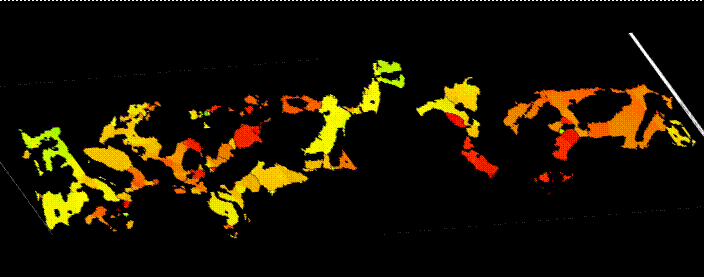
EBSD map of a “single” spinel from
an abyssal peridotite (Achenbach, 2008).
The
spinel aggregate is approximately 1cm long.

Pole
figures for the spinel in the picture above
(Achenbach, 2008)
Magma
generation, migration and crystallisation, including 3-D numerical models of crystallising
media.
(Dr. Mike Cheadle, Dr. Mike
Elliott, Dr. Marion Holness (Cambridge University)).
The group has concentrated on
developing numerical models to mimic the 3-D crystallisation of materials. We
have previously developed 3-D models of texturally equilibrated materials and,
recently, Mike Elliott has developed 3-D numerical models of non-equilibrated
crystallising media. Both single and multiphase systems consisting of different
grain shapes and sizes can be modelled. The computer programs can generate 3-D
images and 2-D slices through both texturally equilibrated and un-equilibrated
materials. These models give insights into the way rocks crystallise and can be
used to test our traditional models of crystallisation. They also permit
calculation of the evolving permeability of a crystallising system and hence
are fundamental to understanding magma generation and migration. One
interesting result is that crystal shape has an extremely important effect on
permeability at porosities of less than 10%.


The pictures
above show the results of the 3-D crystallisation model. The figure on the left
shows a completely crystallised cube of crystals and the lower picture shows
the zoning within those crystals. The figure on the right shows the results of
partially crystallising a cube. The upper figure shows the crystals and the
lower figure the pore space between the crystals.

One of the applications of this work is to test
the validity of dihedral angle measurements on 2-D sections. Here we show that
measurements of the 2-D dihedral angle distribution of pores in a totally
un-equilibrated rock (squares) are very similar to those measured for quartz +
H20 & olivine and H20.
Relevant Publications:
Holness, M., Cheadle, M.J., & McKenzie, D.P. 2005 On the use of changes in dihedral angle to decode late-stage
textural evolution in cumulates. Journal of Petrology 46:
1565-1583; doi:10.1093/petrology/egi026.
Jerram, D.A., Cheadle, M.J. and Philpotts, A.R. 2003 Quantifying the building blocks of
igneous rocks: Are clustered crystal frameworks the foundation? Journal of
Petrology 44, 2033-2051 DOI:
10.1093/petrology/egg069.
Jerram, D.A.
& Cheadle, M.J., 2000. On
the cluster analysis of grains and crystals in rocks. American Mineralogist,
85, 47-67.
Prior, D.J.,
Boyle, A.P., Brenker, F., Cheadle, M.J., Day, A., Lopez, G., Potts, G.J., Reddy, S.M., Spiess, R., Trimby, P.W.,
Wheeler, J., & Zetterström, L., 1999. The application of Electron Backscatter
Diffraction and Orientation Contrast Imaging in the SEM to textural problems in
rocks. American Mineralogist 84, 1741-1759
Elliott, M.T., Cheadle, M.J., & Jerram D.A., 1997. On the Identification of Textural
Equilibrium in Rocks using Dihedral Angle Measurements. Geology, 25, 355-358
Elliott, M.T.
& Cheadle, M.J., 1997. On the
Identification of Textural Equilibrium in Rocks using Dihedral Angle
Measurements, Reply. Geology, 25, 1055.
Bryon, D.N., Atherton, M.P., Cheadle,
M.J. & Hunter, R.H., 1996. Melt movement and the occlusion of
porosity in crystallising granitic
systems, Mineralogical Magazine, 60, 163-171.
Jerram, D.A., Cheadle,
M.J., Hunter, R.H. & Elliott, M.T., 1996. The Spatial Distribution of
Grains & Crystals in rocks. Contributions to Mineralogy & Petrology,
125, 60-74.
back
to Contents
Fluid Flow & Physical Properties of
Rocks
The physical
properties of two-phase systems, and fluid flow in porous media
(Dr. Mike Cheadle, Dr. Mike Elliott, Dr. Heather
Sheldon, Dr John Wheeler (University of Liverpool, UK).
The models mentioned above allow predictions of the evolving
physical properties (seismic velocity, electrical conductivity and
permeability) of fluid bearing media. Knowledge of these properties is
essential to interpret the results of geophysical investigations of magma
chambers (for example beneath mid-ocean-ridges). The result that crystal shape
is important at low porosities has important implications for the volumes of
magma present in magma chambers. Heather Sheldon examined the effects of the
physical and chemical processes that
occur on the crystal scale during fluid flow. We are investigating the effect
of the complicated feedback between precipitation and dissolution on
permeability as a fluid in chemical dis-equilibrium
with the solid phase moves through its host rock.



Pore space
geometries of perfectly texturally equilibrated materials (the figure on the
left has a dihedral angle of 1o and a very low porosity, the one in
the centre has a dihedral angle of 60o and the one on the right has
a dihedral angle of 180o

Animation showing the occlusion of porosity.
Watch a portion of a rock crystallise!

The effect of the geometry of crystals on the electrical
conductivity of rocks.
Relevant Publications:
Cheadle, M.J., Elliott,
M.T., and McKenzie D.P., 2004. The Percolation Threshold and
Permeability of Crystallizing Igneous Rocks:
The Importance of Textural Equilibrium. Geology 32, 757-760.
Sheldon, H., Wheeler J., Worden R., Cheadle M.J., and Lind A. The importance of effective stress as the driving force for chemical
compaction, 2003 Journal of Sedimentary Research
Elliott, M.T., Cheadle, M.J., & Jerram D.A., 1997. On the Identification of Textural
Equilibrium in Rocks using Dihedral Angle Measurements. Geology, 25, 355-358.
Bryon, D.N.,
Atherton, M.P., Cheadle, M.J. &
Hunter, R.H., 1996. Melt movement and the occlusion of porosity in crystallising granitic systems,
Mineralogical Magazine, 60, 163-171.
back to Contents
Origin of Granitic
Magmas
The generation
and migration of silicic magmas
(Dr. Mike Cheadle, Dr Matt
Jackson, Dr. Heather Sheldon, Dr. Mike Atherton (University of Liverpool, UK)).
Matt Jackson produced numerical models for the generation of
silicic magmas by melting the lower crust. The
important result is that the process of melt generation and migration through a
thermal gradient naturally leads to the production of a large volume of a melt
which is chemically the low melt fraction of the lower crust. This result
implies that the tectonic ‘squeezing’ advocated by some, to explain the
generation of a large volume of a small melt fraction, is not necessary.
Heather Sheldon has devised a phase-diagram based numerical model, which
permits investigation of the effects of spatial variations in the initial
composition of the source rock. She shows that a compositionally layered source
rock may develop local pockets of melt, wherever there is an upward change to a
more refractory composition. This spatially complex distribution of melt and
solid is eventually smoothed out by the passing of a larger porosity wave, if
heating continues for long enough.
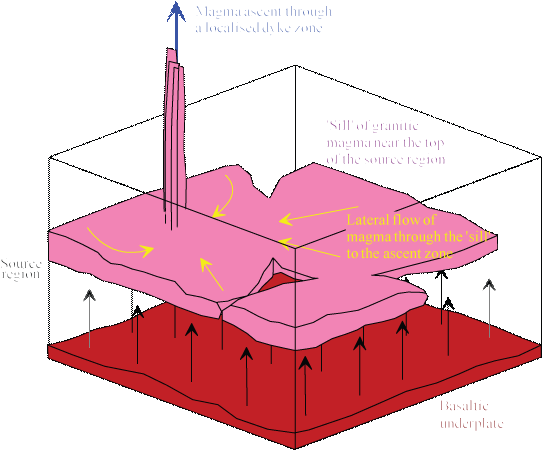
Granitic Magma: Transition from Segregation to Ascent
(after Matt Jackson)
.
Relevant Publications:
Jackson, M.D, Gallagher, K. Petford,
N. & Cheadle M.J., 2005 Towards a coupled physical and
chemical model for tonalite–trondhjemite–granodiorite magma formation: Lithos
79, 43-60.
Jackson, M.D., Cheadle, M.J. and Atherton M.P. 2003
Quantitative modeling of granitic
melt generation and segregation in the continental crust, In Press: Journal of
Geophysical Research
Jackson, M.
& Cheadle, M.J., 1998. A Continuum model for the
transport of heat, mass and momentum in a deformable, multi-component mush,
undergoing solid-liquid phase change, International Journal of Heat & Mass
Transfer, 41, 1035-1048.
back to Contents
Origin & Evolution of Sedimentary
Basins
The processes
of crustal extension at continental margins.
Amy Heath (co-supervised by Dr. Pat Shannon (UCD)& Prof. N.J. Kusznir) used
seismic & bore-hole data to study the Rockall Trough (West of Ireland).
This basin is a prime example of a rift basin that shows evidence of extensive crustal thinning, but little brittle faulting. Amy is
hoping to determine whether the continental crust ‘broke’ beneath the Rockall
Trough.
Relevant Publications:
Fletcher,
R.; Kusznir, N.J.,
Cheadle, M.J., 2008
(in press). Melt initiation and mantle exhumation at the Iberian
rifted margin: Comparison of pure-shear and upwelling-divergent flow
models of continental breakup. (Geophysical Journal of the Royal Astronomical
Society)
Nadin, P.A., Kusznir, N.J., & Cheadle, M.J.,
1997. Early Tertiary plume Uplift of the North Sea & Faeroe-Shetland
Basins. E.P.S.L., 148, 109-127.
Cheadle, M.J., S. McGeary,
M. Warner and D.H. Matthews, 1987. Extensional
structures on the western UK continental shelf: a review of evidence from deep
seismic profiling. (in) Coward, M.P., Dewey, J.F. and
Hancock, P.L. (eds)
Continental Extensional Tectonics, Geological Society Special Publication No.
28, 445-465.
McGeary ,S.,
M.J. Cheadle, M. Warner, and D.J.
Blundell, 1987. Crustal structure of the continental
shelf around Britain
derived from BIRPS deep seismic profiling. (in), J. Brooks and K. Glennie
(eds) Petroleum Geology of North West Europe, vol. 1,
Graham & Trotman, London.
back to Contents
Future Research
Future research plans involve the continuation and
development of the projects listed above. In particular:
i) Understanding the origin and generation of slow spreading oceanic
crust using the novel application of geo- and thermo-chronologic techniques.
Additionally understanding the origin of oceanic core complexes: structure
& flexure.
ii)
The origin of layered Intrusions, igneous cumulates and platinum
deposits, with future work including the Dufek
Intrusion,
Antarctica, the Stillwater Complex, the Bushveld
Intrusion & the Rum Intrusion.
iii)
Application of seismic stratigraphy to
understanding Igneous Intrusions.
iv)
Textural studies and better numerical modelling of the evolution
between texturally equilibrated and texturally un-equilibrated rocks. (What is
the real permeability of the mantle? How are melts extracted? And in different
environments {M.O.R’s & Subduction
zones}).
v)
The origin of Komatiites.
vi)
Studies of the magmatism of the British
margin of the North Atlantic Igneous Province.
vii)
Continuing research into the generation, migration, and
emplacement of granites.
viiiInvestigating the processes of formation of ocean crust at fast spreading ridges: gabbro glacier flow or multiple sill injection?.
Back
to Contents
People, Past & Present
 Dr. Mike Cheadle mailto:(cheadle@uwyo.edu)
Dr. Mike Cheadle mailto:(cheadle@uwyo.edu)
Current Graduate Students
 Tyler Brown mailto:tbrown46@uwyo.edu
Tyler Brown mailto:tbrown46@uwyo.edu
 Jake Carnes mailto:jcarnes1@uwyo.edu
Jake Carnes mailto:jcarnes1@uwyo.edu
 Lauren Colwell mailto:lcolwell@uwyo.edu
Lauren Colwell mailto:lcolwell@uwyo.edu
 Scott Badham
Scott Badham
Graduate Students who’ve
graduated
 Chris Christofferson (Cabot Oil)
Chris Christofferson (Cabot Oil)
 Nicole Schoolmeesters (Twin Metals, Minesota)
Nicole Schoolmeesters (Twin Metals, Minesota)
 Matt Lusk (Shell)
Matt Lusk (Shell)
 Dr Kay Achenbach
Dr Kay Achenbach
 Dr Craig Grimes Professor University of Ohio mailto:grimesc1@ohio.edu
Dr Craig Grimes Professor University of Ohio mailto:grimesc1@ohio.edu
 Dr. Graham Baines Research Scientist mailto:graham.baines@adelaide.edu.au
Dr. Graham Baines Research Scientist mailto:graham.baines@adelaide.edu.au
 Lars Hansen (Now
a Postdoc at
Stanford University
)
Lars Hansen (Now
a Postdoc at
Stanford University
)
 Caroline LoRe (now a PhD student at Wyoming)
Caroline LoRe (now a PhD student at Wyoming)
 Dr. Heather Sheldon Research Scientist mailto:Heather.Sheldon@csiro.edu
Dr. Heather Sheldon Research Scientist mailto:Heather.Sheldon@csiro.edu
 Dr. Dougal Jerram Consultant geologist, earth scientist, adventurer
Dr Volcano
Dr. Dougal Jerram Consultant geologist, earth scientist, adventurer
Dr Volcano
 Dr. Matt Jackson (Pofessor,
Imperial
College)
Dr. Matt Jackson (Pofessor,
Imperial
College)
 Dr.
Mike Elliott (BP-Amoco)
Dr.
Mike Elliott (BP-Amoco)
 Dr.
Amy Heath
Dr.
Amy Heath
 Dr.
Kath Silva (Shell)
Dr.
Kath Silva (Shell)
 Dr. Fiona Sargeant
Dr. Fiona Sargeant
 Dr. Lisa Worrell (Merebrook
Environmental Engineering Consultants)
Dr. Lisa Worrell (Merebrook
Environmental Engineering Consultants)
Back to Contents
Biographical
Information: Dr. Mike Cheadle
Personal
Details:
Current Employment: Associate Professor in Geophysics,
University of Wyoming.
Current
Address: Department
of Geology & Geophysics,
University
of Wyoming,
Laramie,
U.S.A. 82071.
Telephone: (307) 766 3206
E-mail: cheadle@uwyo.edu
Education & Qualifications:
Ph.D. Geophysics: “Properties of Texturally Equilibrated
Two-Phase Aggregates”,
1989. Cambridge
University, Cambridge, England.
M.Sc.Geophysics: ‘The
deep crustal structure of the Mojave Desert,
California, from
1984. COCORP seismic reflection data”,
Cornell
University, Ithaca, New York, USA.
B.A.(Hons)
Geology: St. Edmund Hall, Oxford University, Oxford,
1981.
England.
Back
to Contents
Last revised: Date 7/09/12
The Phases of the Moon


![]() Processes at Slow Spreading Ridges
Processes at Slow Spreading Ridges![]() Fluid Flow &
Physical Properties of Rocks
Fluid Flow &
Physical Properties of Rocks![]() Origin
& Evolution of Sedimentary Basins
Origin
& Evolution of Sedimentary Basins ![]() Biographical
Information & who to contact: Dr. M.J. Cheadle mailto:(cheadle@uwyo.edu)
Biographical
Information & who to contact: Dr. M.J. Cheadle mailto:(cheadle@uwyo.edu)
































